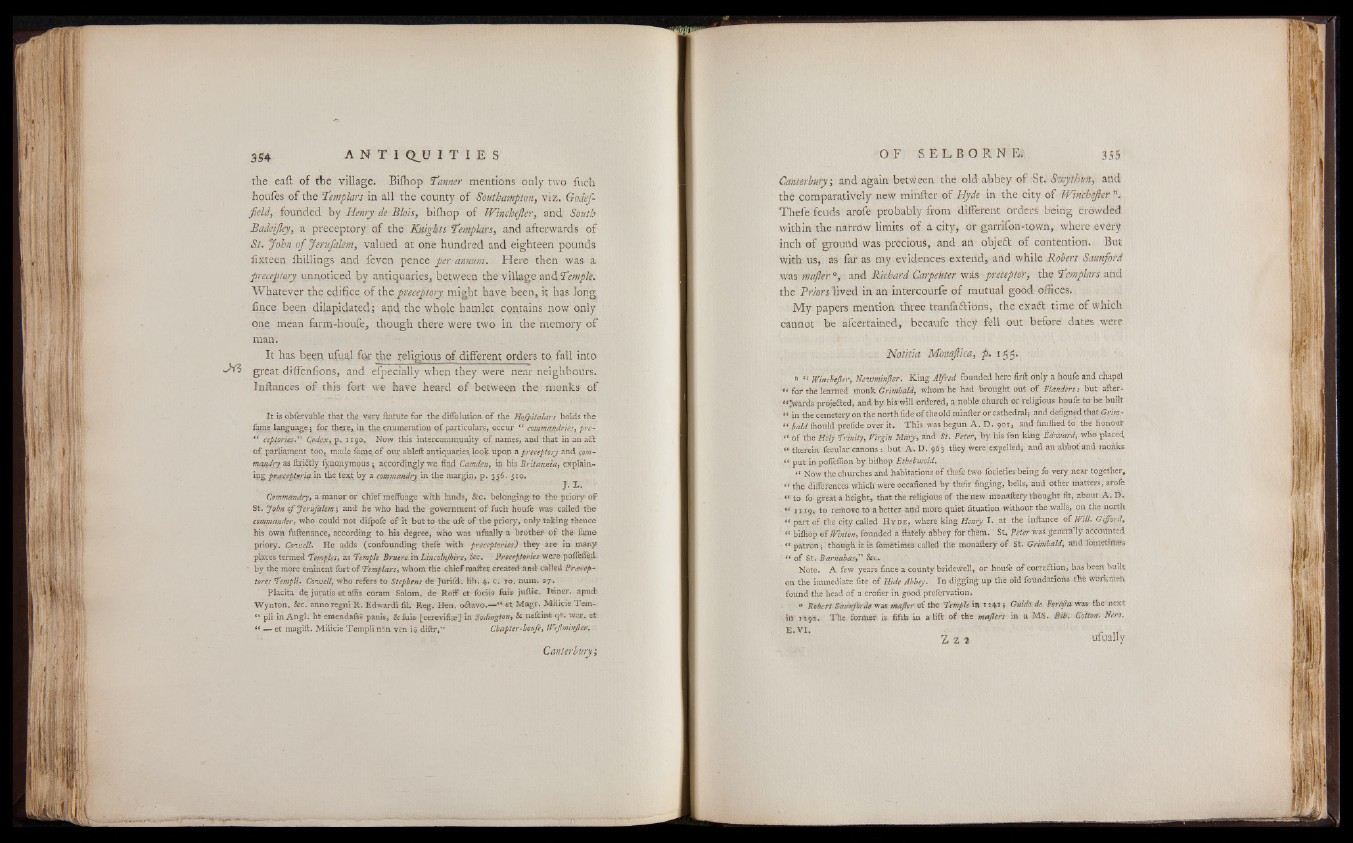
the eaft of the village. Bilhop 'Tanner mentions only two fuch
houfes of the Templars in all the county of Southampton, viz. Godef-
field, founded by Henry de Blots, bilhop of Winchejler, and. South
Badeijley, a preceptory of the Knights Templars, and afterwards of
St. John of Jerufalem, valued at one hundred and eighteen pounds
lixteen lhillings and feven pence per annum. Here then was a
precepjory unpoticed by antiquaries, between the village aadTemple.
Whatever the edifice of the preceptory might have been, it has long
lince been dilapidated; and the whole hamlet contains now oply
one, mean farm-houfe, though there were two in the memory of
man.
It has been ufual for the feligiaus of different orders to fall into
great diffenfions, and efpecially when they were near neighbours..
In dances of this fort we have heard of between the monks of
I t is obfefvable that the very ftatute for the diffolution o f the Hofpkalars holds the
fame language ^ for there,, in the enumeration o f particulars, occur “ cojnmajidnes, pre-
“ ceplories.” Codex, v* 1190» Now this intercommunity o f names, and Mat in an a6t
o f .parliament too,t made fome o f our ableft antiquaries, look upon a preceptary and .tjojm-
mayidry as ftrifitly lyn,pnymous \ accordingly we. find Camden, in his Britannia, explaining
pracepppria in the text by a conjmandry in the margin, p. 356. 510.
J .L .
Commandry, a manor o r chief mefluage with lands, See. belonging- to the priory o f
St. John of Jerufalem; and he who had the government o f fuch houfe was called the
commander, who could not dllpofe o f'it but to the ufe o f the priory, only taking thence
his own fuftenance, according to his degree, who was ufually a brother o f the lame-
priory. Connell. He adds (confounding thefe with preceptories) they are in many
places termed ’Temples, as Temple Bruere in Lincoltijbire, Sec. Frec-epjomes- were poffelfiad
• by the more eminent fort o f Templars, whom the chief matter created and called Bracep~
tores Templi. Connell', who refers to Stephens de Jurifd. lib. 4. c. xo. num. 2-7.
Placita de juratis et affis coram Salom. de Roff et foetis fois- juftie. Iciner. apud
Wynton. &c. annoregni R. Edwardi fiL Reg. Hen. ofibavo.— u et Magr. Milicie Tem-
“ pli in A n g l. hfr eraendafte panis, &£uis- [-eerevifiae]; in Sodimgton, Sc nefeiitf q*. war. et
“ — et magift. Milicie Templi non ven io diltr,” Chapter-houfe, Wefminjlen.
Canterbury^
Canterbury; and again between the old abbey of St. <Swylbun, and
the comparatively new minfter of Hyde in the city of Winchejler ".
Thefe feuds arofe probably from different orders being crowded
within the narrow limits of a city, or garrifon-town, where .every
inch of ground was precious, and an objedt of contention. But
with us, as far as my evidences extend, and while Robert Saunford
was mafter°, and Richard Carpenter was preceptor, the Templars ahd
the Priors lived in an intercourfe of mutual good offices.
My papers mention three tranfaftibns, the eXadt time of which
cannot be afeertained, becaufe they fell out before dates were
Notitia Monafiica, p. igg.
n “ Winchejler, Newminjler. King Alfred founded here firft only a houfe and chapel
M for the leattied monk Grimbali, whom he had brought out o f Fldndbn: but aftef--
«‘ *wards projefled, and b y his will ordered, a noble church or religious houfe to be built
“ in the cemetery on the north fide o f the old minfter or cathedral) and deligned that Grim-
“ .lald (hould preiide over it. This was begun A . D. 901, and finilhed to the Honour
“ Of the Hot} Trinity, Virgin Maty, and St. Peter, by his fon king Edward, who placed,
«‘ therein fecular canons:. but A .D . 963 they were expelled; and an abbot and monks
. “ put in pofieflion by bilhop Ethehwold.
•« Now the churches and habitations o f thefe two focieties being fo very near together,
“ the differences which were occafioned by their finging, bells, and other matters, afofe
“ to fo great a Height, that the religious of the new monaftery thought fit, about A . D.
*« 1119, to remove to abetter and more quiet iituation without the walls, on the north
“ part o f the city called Hyde, where king Henry I. at the inllance o f Will. Gifford,
« bilhop of Witifon, founded a ftately abbey for them.' St. Peter was genbft’ly amounted
“ patron; though it is lometimes called the monaftery o f St. Grwnbald, and fontethbes
“ o f St. Barnabas,” &c.
Note. A few years fince a county bridewell, or houfe o f corre£tion, has been built
on the immediate fite of Hide Abbey. In digging up the old 'foundations the workmen
found the head of a crofier in good prefervation.
0 Robert Saunforde was mafter of the Temple in } Guido de Forefla was the' next
in 1192, The former is fifth in a lift o f the majlirs in a MS. Bib. Cotton. Nerd.
E. VI.